Fashion is the heartbeat of drag performances, serving pomp brimming with craftsmanship and self-expression. Behind three drag acts in Mumbai, five artists let us into their atelier
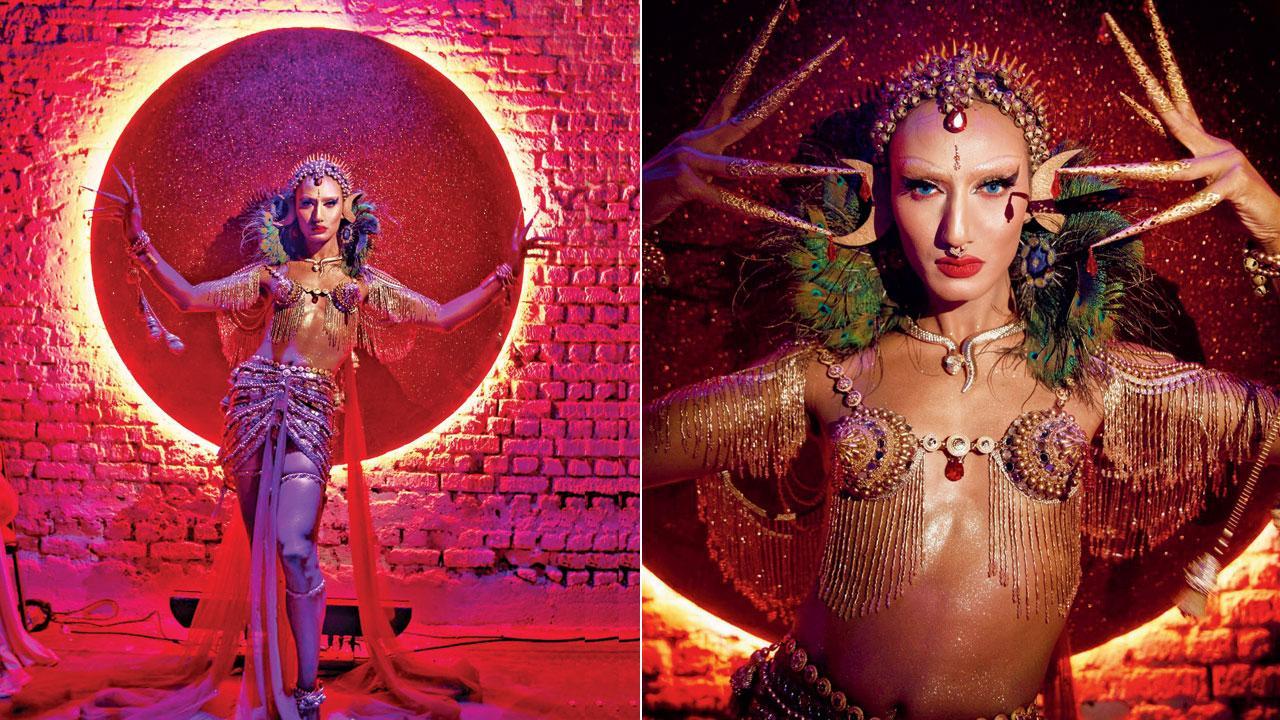
“Fashion is our canvas for expression and transformation. But without designers catering to queer community, we rely on our own ingenuity and resources to make it work,” Glorious Luna says. Pic Courtesy/Mohit Varu, Dirty Magazine
 Divalicious and fabulously queer, when drag performers step onto the stage, they enter a transitional space where all notions of conventions slip away, blending performances with parodic femme-ness and mythological self-sculpting. “Drag allows me to tap into my happy feeling,” says Delhi-based drag performer Lush Monsoon.
Divalicious and fabulously queer, when drag performers step onto the stage, they enter a transitional space where all notions of conventions slip away, blending performances with parodic femme-ness and mythological self-sculpting. “Drag allows me to tap into my happy feeling,” says Delhi-based drag performer Lush Monsoon.
ADVERTISEMENT
Drag encompasses more than just the contouring, the gluing of eyelashes, and the securing of wigs. It’s a celebration of progress and joy within the community, for whom song and dance is deeply ingrained in cultural expression. Together, they foster camaraderie, werking the collaborative spirit of a divine sisterhood.
We were privy recently to this communal spirit and the remarkable ingenuity that goes into creating their drag personas. And we couldn’t help but think they could rival the whims guiding the Met Gala.
‘My attire featured 400 different stitched-on ghungroos’
Glorious Luna, 31,
Model-drag artist-entrepreneur, launched IT Ball, India’s first drag ballroom night in Mumbai. Identifies as non-binary (he/she/they)
We live in a radical time with safe spaces available to lesbians and gay persons, but not much for those who identify as non-binary and express themselves in the language of fashion. So, a small group, part of the House of Luna, decided, ‘Let’s change that!’” This is how the IT Ball was launched in 2023, which Glorious Luna clarifies is not a competition. “It’s about throwing a bash where every single person who shows up is a star.”
At the IT Ball 02 show in Mumbai last month, she announced: “It took 14 days, 100-plus hours and three people [including Pramod Bhange and Krisha] to make this custom look. It’s fully hand-stitched, making it couture.” Indeed, it was couture in its most avant-garde form, right down to the shoes. Her barely-there bustier and dhoti-skirt was accessorised with old pumps revamped with mirrors and ghungroos. “It gave off a Jeremy Scott-Moschino vibe, don’t you think?”
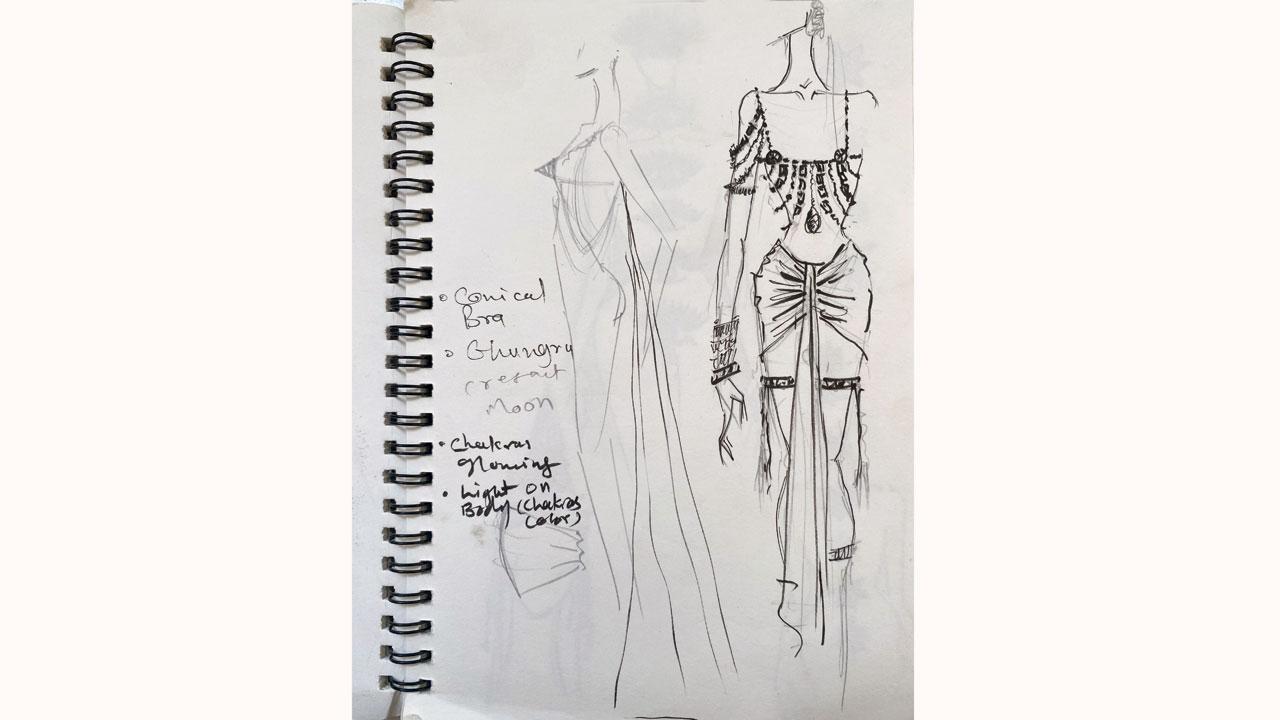 Glorious Luna’s initial sketch of the outfit
Glorious Luna’s initial sketch of the outfit
In resonance with the overarching theme of Godx and Goddexxes, Glorious Luna chose to play a flamboyant Nataraja—the divine cosmic dancer avatar of Lord Shiva, famed as ardhanarishwar, embodying both feminine and masculine energies in harmonious union.
After several trips to Bhuleshwar market, she found the perfect fabric—the net—for her dhoti-skirt intricately pleated in the front, which she paired with a conical tasseled bustier oozing red crystal denoting the cycle of life, death and rebirth. She describes the final design as a blend of influences, including the Thai Apsara dancers, Naomi Campbell in John Galliano’s autumn/winter 1997 Dior couture costume, and French couturier Jean Paul Gaultier’s bullet brassiere.
“The standout feature was the 400-plus ghungroos in varied shapes, the matha patti [repurposed from a skirt belt] alone had 150 ghungroos stitched on,” says the drag artist, who, despite lacking formal fashion training, sketches and designs her outfits. A peacock shrug, extra-long enamel nails, a serpent choker and ruby droplet positioned on the forehead to denote the “third eye”—everything was repurposed from jewellery drawers.
The hair and makeup mood-board drew from Indian temple sculpture, featuring brows that arched impossibly high, a touch of red eye shadow and bold scarlet lips, all done by Glorious Luna herself.
‘It was tough to find a masterji willing to make women’s costumes for men’
Lush monsoon, 31
Human rights lawyer-drag performer and member of Mehfil-e-Drag ensemble. Identifies as non-binary (she/her/they/them)
In Mehfil-e-Drag, we flipped the script on the history of tawaifs with a queer twist. There’s a lot to love here: a dazzling 30 minutes filled with a wonderfully intimate energy, and it is happily queerer than the recent Sanjay Leela Bhansali opus, Heeramandi (Lush Monsoon identifies with Manisha Koirala’s character, Mallikajaan). The song-and-dance numbers blend genres, styles and cultures, from Pakeezah and Umrao Jaan to Devdas and the recent Netflix series.
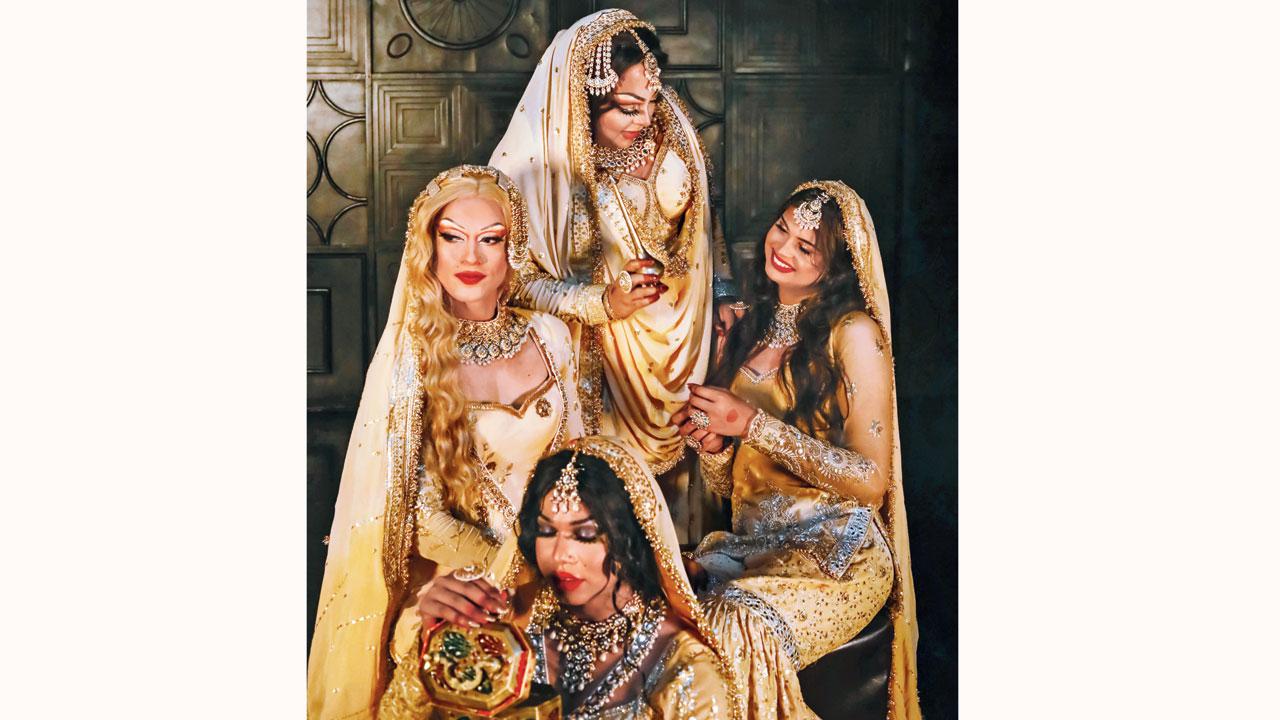 Lush Monsoon (standing) with Mehfil-e-Drag cast, including Hash Brownie, Betta Naan Stop and Whacker Cracker at Kitty Su nightclub. Pic Courtesy/Kitty Su
Lush Monsoon (standing) with Mehfil-e-Drag cast, including Hash Brownie, Betta Naan Stop and Whacker Cracker at Kitty Su nightclub. Pic Courtesy/Kitty Su
Lush and Hash Brownie reign as the elder queens of their gharanas, while Betta Naan Stop and Whacker Cracker represent the spirited, hopeful youth. “It’s about subtly peeling back the intricacies of our relationships and dynamics, as we transport you to the heart of gharana culture,” Lush says in a phone interview.
Costumes were critical, but with limited funds and no access to designers, Lush and her “drag sister” Hash got creative, scouring Katran Bazaar, a wholesale cloth market in New Delhi’s Mangolpuri, for embellished georgette that would twirl elegantly as they danced. “Finding a tailor open to stitching outfits for men proved to be a challenge, but we finally found a masterji in Seelampur.”
“Drag is about jugaad,” she says. While Heeramandi boasts 300 kgs of jewellery crafted reportedly from real rubies, emeralds, cultured diamonds and polki, the Mehfil-e-Drag crew had to rely on rented costume jewellery. Lush’s Anarkali ensemble, bling included, ran a tab of Rs 20,000. “We did our own makeup—the fun part we all love. Isn’t it funny how it takes three hours for makeup, but just five minutes to wipe it off?”
Lush, a body-positive model has struggled with distorted body image since childhood, which has impacted her experience in the drag scene where physical appearance takes centre stage. “I’ve received comments on my drag persona, being compared to an XXL Mallikajaan. But as I learn to let go of shame, remarks don’t hold power over me.”
Rs 20,000
Cost of making Lush’s Anarkali ensemble
‘Drag stretches the boundaries of fashion’
Zeesh, 30,
Drag artist and host of the 9th edition of Kittyversary. Identifies as non-binary (he/she/they)
What becomes of a wedding lehenga—once brimming with hope, now burdened by the painful memory of a couple’s divorce? “It is transformed into a celebrated piece of clothing,” says Zeeshan aka Zeesh, who designs her own outfits, ensuring they are repurposed from hand-me-downs or thrift store finds.
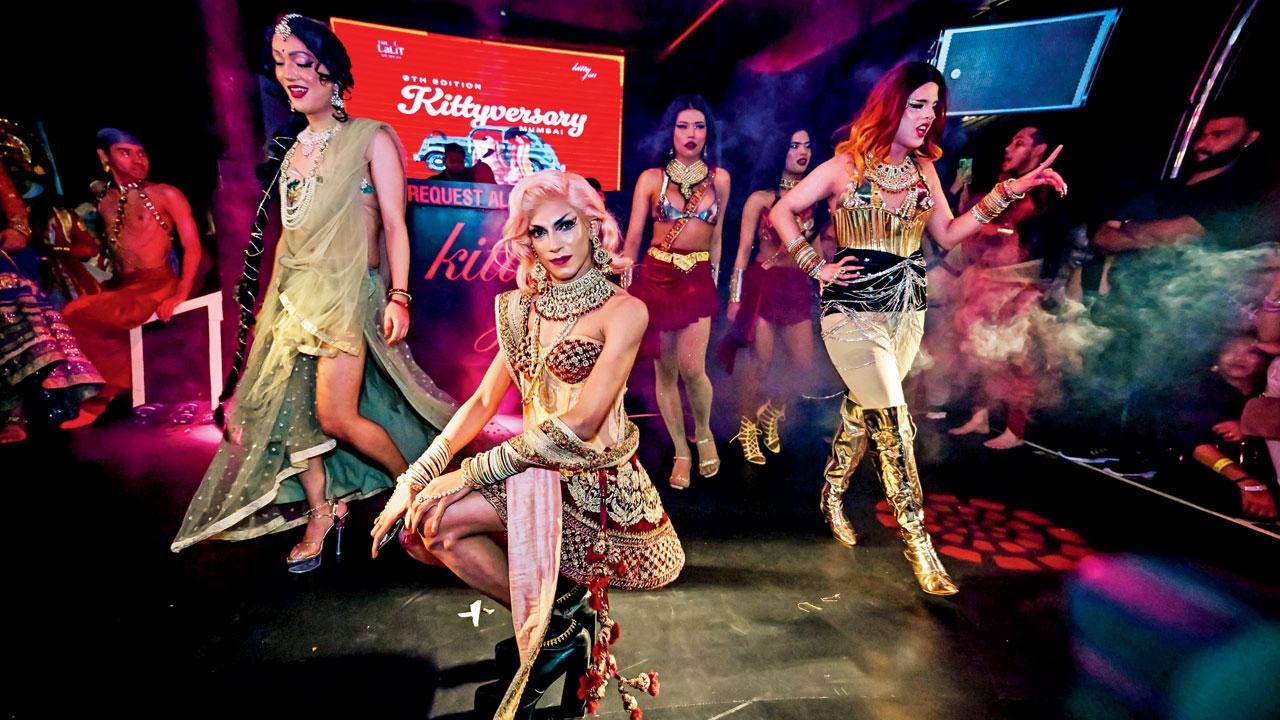 “Drag is my passion, my art, my sense of belonging. This is something that I am good at, whether I am painting my face, repurposing my outfits, performing, or hosting events at Kitty Su,” Zeeshan says. Pic Courtesy/Wanda Amber Hendrick
“Drag is my passion, my art, my sense of belonging. This is something that I am good at, whether I am painting my face, repurposing my outfits, performing, or hosting events at Kitty Su,” Zeeshan says. Pic Courtesy/Wanda Amber Hendrick
The right to marry is a significant experience denied to LGBTQiA+ individuals in India. So, when a friend donated her zardozi wedding lehenga to Zeeshan, she saw an opportunity. “I wanted to bring a campy element to the basic bridal look. With the help of my tailor Raju bhai from Vakola, we shortened the floor-length lehenga into a flared skirt. We repurposed the dupatta to make a sash, bustier and bust cups. I still have excess fabric remaining which I plan to use in future costumes.”
Zeeshan’s mother sourced the jewellery: bangles, cummerbund, necklace and jhumkas, by rummaging through her own trinket box and shopping at a wholesale market in Malad.
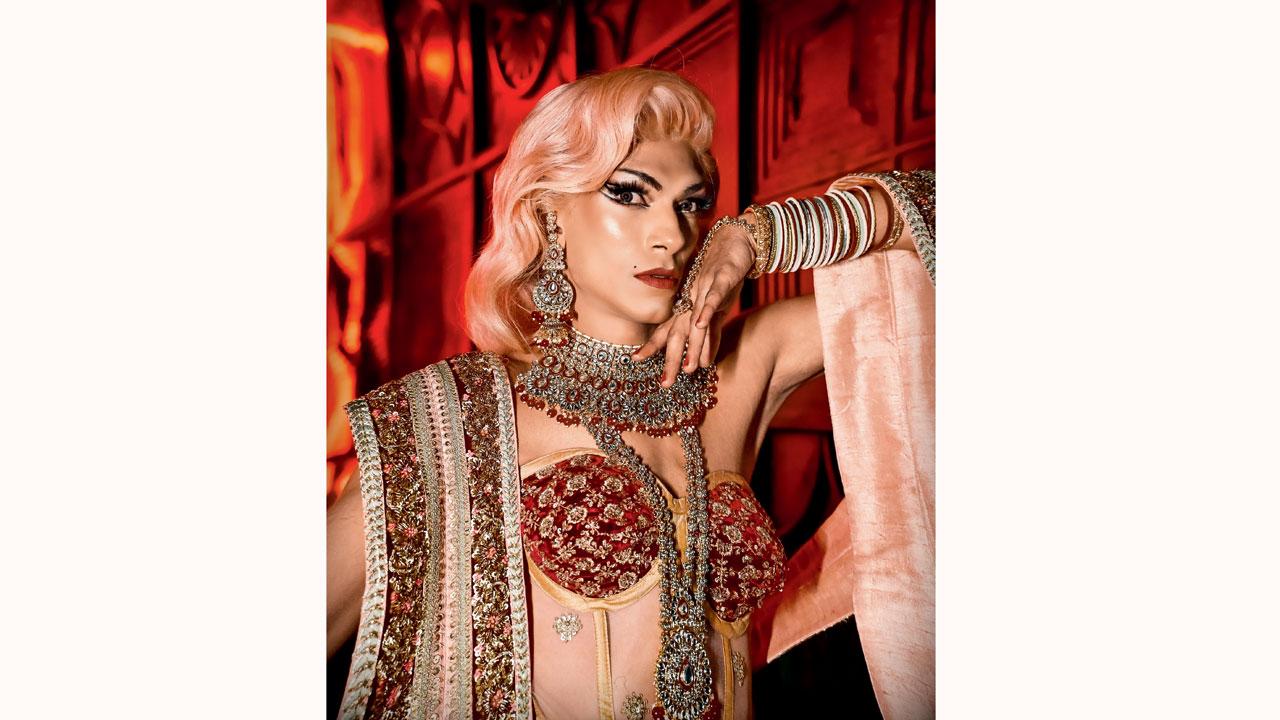
From the early days of drag, Zeeshan has been fascinated with makeup, often experimenting with face paint in the sanctuary of the bedroom. “It is where I learned the ropes of DIY-ing, and I still do my own makeup.”
‘I live my fantasy through my outfits’
Nin Kala, 27
Model-entrepreneur-artist Identifies as non-binary (she/her), participated in both editions of IT Ball
Nin Kala was probably the only participant at the IT Ball 02 party to have two outfit changes. “I had actually planned three,” she admits rather sheepishly, “but settled on two, totalling Rs 12K in expenses.”
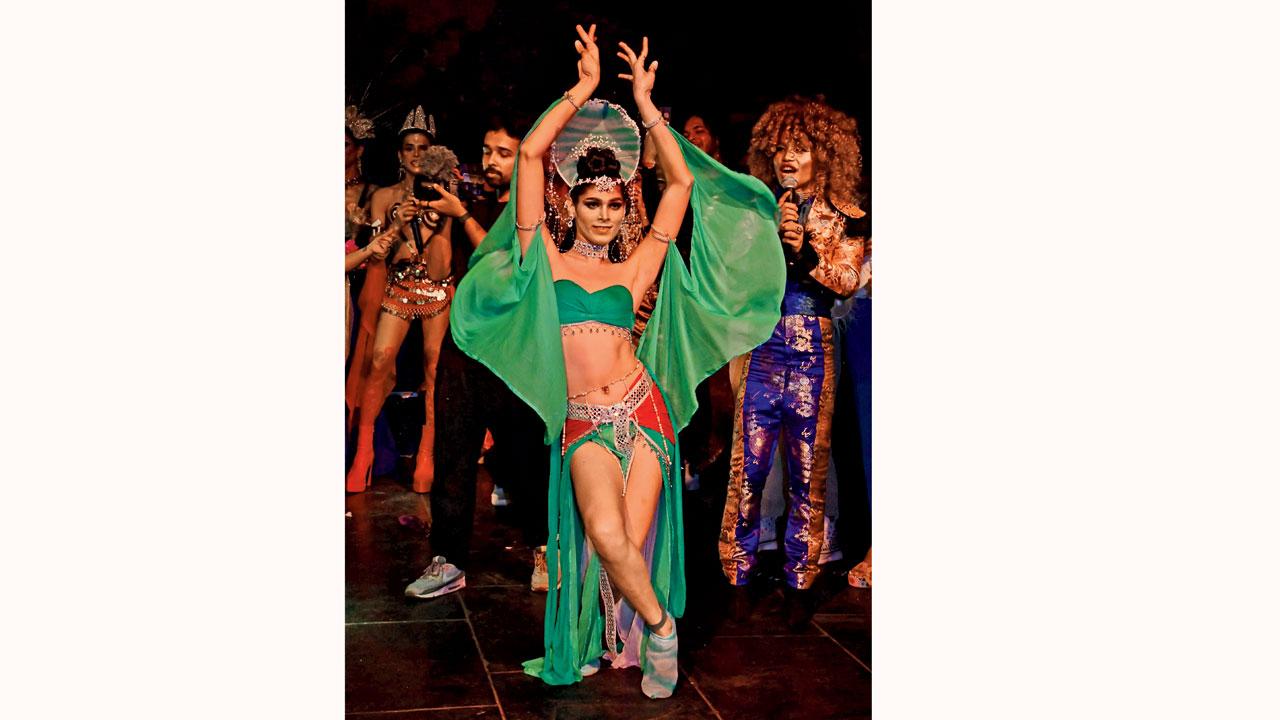 Nin Kala’s two ensembles showcased the art of DIY fashion on a budget. Pics Courtesy/Ak Mishra & Mohit Varu, Dirty Magazine
Nin Kala’s two ensembles showcased the art of DIY fashion on a budget. Pics Courtesy/Ak Mishra & Mohit Varu, Dirty Magazine
For the first outfit, Nin looked at Goddess Saraswati, envisioning an embellished bell-bottom bodysuit tailored by Altaf bhai. But it was the elaborately detailed accessories, including the headgear and cummerbund, all hand-stitched by Nin over 10 days that stole the spotlight. She stumbled upon a readymade fabric swatch at the Chindi Market in Kurla, typically used to embellish the yoke of kurtas. “For me, it made for a stunning headpiece.” The circular crochet zari hoops, each priced at Rs 7, were sourced from Bhuleshwar. “The rest of the jewellery, borrowed from Luna [Glorious Luna] and Rutviq, comprised a choker, earrings, neckpiece and beads were originally part of a bridal set.” And the bangles? “They are not bangles, but elements used in wedding stage décor,” Nin explains, stressing how each piece was crafted either as standalone or with elastic bands for effortless dressing.
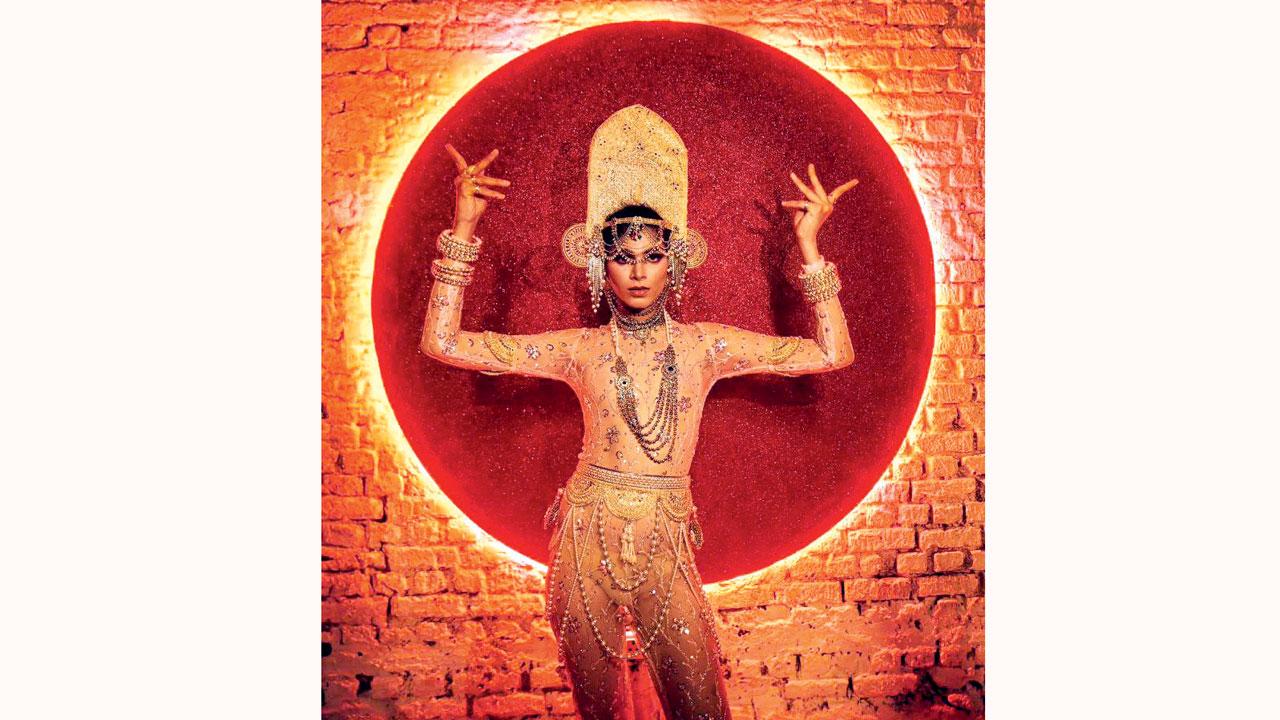
Green Tara, revered as the fully enlightened female Buddha, infused vitality into the second outfit, hand-stitched by Nin from four recycled dupattas sourced from scrap dealers in Dharavi. “I used the dark green dupatta to cover my ballerina shoes and brassier for the appearance of a bustier,” says Nin, who makes up for lack of an illustration training with imagination. “I embrace my fantasy through my outfits and performances, seeing myself as someone extravagant and extraordinary.”
10
days for Nin Kala to hand-stitch her accessories
‘The conch corset, 3D printed in Dadar, weighed four kilos’
Deedeepls, 31
Illustrator-drag artist, performed the opening act at the IT Ball 02. Identifies as non-binary (he/she)
Walking in six-feet platform stiletto boots, with a crown of 120 peacock feathers and a corset of horns, a tall, lean figure towered over the crowd like an otherworldly monarch. As the music gained tempo, the figure began to sway, the long sleeves of royal blue taffeta moving in a puppet-like dance, her gestures alternating between robotic and languid. With a lift of her head, her face revealed fake eyelashes, pencil-thin brows, and extreme contouring cascading down her cheeks, all converging towards a bug-like mouth painted in bold red.
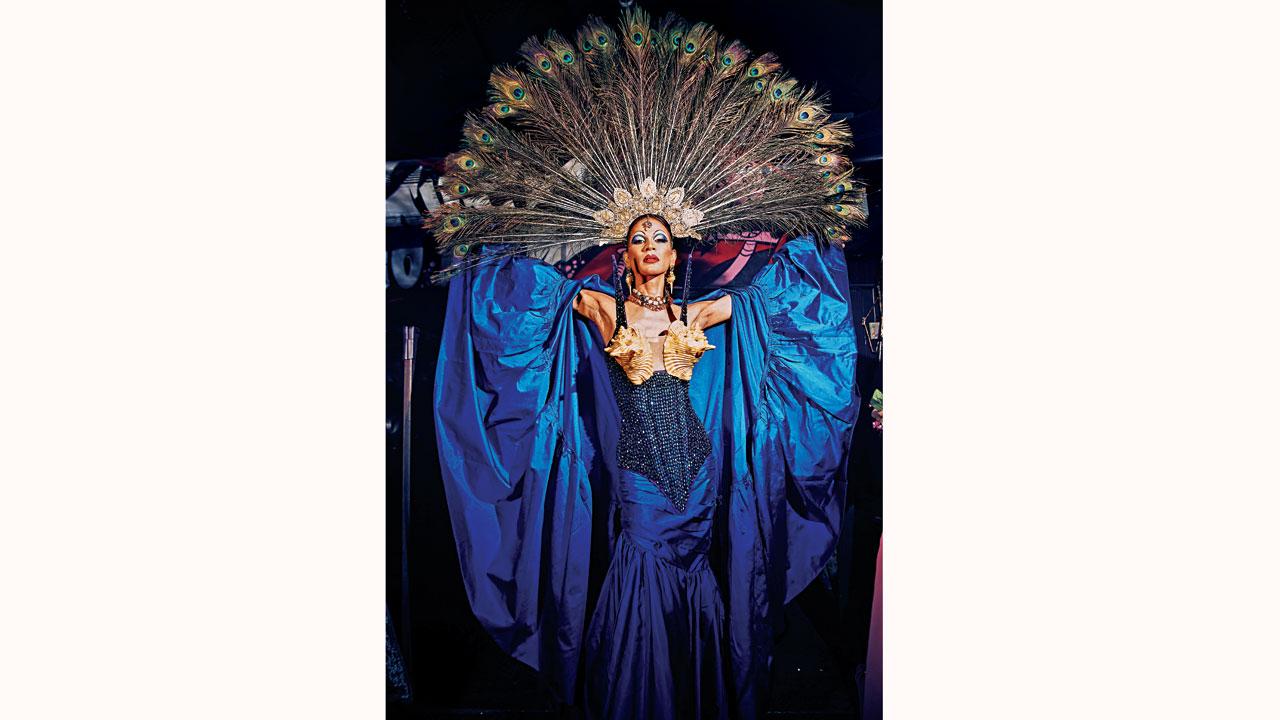 “The green bangles in my costume completed my look, mirroring those worn by married Marathi women and adding femme-ness into my act,” says Deedeepls. Pic Courtesy/Mohit Varu, Dirty Magazine
“The green bangles in my costume completed my look, mirroring those worn by married Marathi women and adding femme-ness into my act,” says Deedeepls. Pic Courtesy/Mohit Varu, Dirty Magazine
The opening act of IT Ball 02, led by drag artist Deedeepls, gave us a sartorial portrayal of the feminine aspect of Lord Vishnu.
Creating the look was a two-week affair, but Deedeepls had been sketching technical flats and planning every detail long before. Each feather had to be individually inserted into two-inch water-filter pipes to stand upright. Before entrusting her Bandra-based tailor Sarfaraz with stitching the billowy mermaid silhouette, she scoured the local markets for 30 metres of taffeta.
What really kept Deedeepls up at night was the making of the surrealist corset with conch sitting on the bosom—an homage to her favourite couturier, Schiaparelli. “The corset weighed a whopping four kilos! It took a solid 12 days just to get the boning and form right. To add to the fun, the beads kept unravelling until the day of the show,” laughs the artist, sharing her experience of getting a polymer-based pair of conch 3D printed in Dadar and tracking down 1,000 stone and glass beads for the body of the corset.
Deedeepls’s mother, Laxmi Sharma, cheered proudly from the sidelines, especially loving the peacock head gear. “Her support means the world to me; her approval is everything.”
 Subscribe today by clicking the link and stay updated with the latest news!" Click here!
Subscribe today by clicking the link and stay updated with the latest news!" Click here!







